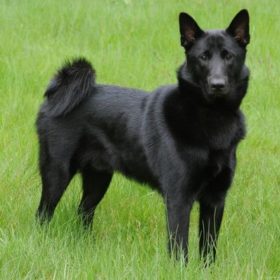Weimaraner

The Weimaraner is a versatile hunting dog with great physical stamina. Although they are slower than other hunting dogs, they are attentive and work-oriented. Very intelligent and courageous, Weimaraners are attached to their owners. Fear of separation is characteristic of these dogs. They will bark, howl, and panic, wrecking everything around them.
Table of Contents
Breed Information
| Another Name | – |
| Origin | Germany |
| Height | Males 63-68 cm Females 58-63 cm |
| Weight | Males 32-37 kg Females 25-32 kg |
| Fur | Short, thick |
| Color | Charcoal blue, mouse blue, gray, silver-gray, blue-gray |
| Lifespan | 11-14 years |
| FCI Classification | Pointing Dogs |
| Group | Dogs for children, hunting, guarding, for the apartment |
| Price | From $600 |
Breed Photos
Origin History
Weimaraners probably originated in the 13th century and were used for hunting in the court of King Louis IX of France. Some think that the Weimaraner was descended from the St. Hubert’s hound (or bloodhound).
In any case, the Weimaraner we know today began developing as a breed in the late 18th and early 19th centuries in the city of Weimar, hence the name. They are believed to be a mixture of the Bloodhound, English Poynter, German Shorthair Poynter, and Blue German Dane.
Back in the 19th century, the Weimaraner, or Weimar Poynter as it was then called, was used for hunting big game such as deer, bears, and wolves. When the German forests began to disappear with these animals, the breed was used for hunting smaller prey. They were bred exclusively for the nobility, who wanted a hunting dog of royal appearance. Weimaraners were kept at home, not in kennels like other hunting dogs. That is why they have the character of a family dog. In 1897, the nobles created an exclusive club to maintain the breed’s standards and control them. Anyone who wanted to buy a Weimaraner had to be a member of the club. The Germans were so proud of their unique breed that dogs sent to America were sprayed to prevent breeding and increase their numbers.
In 1929 Howard Knight, an American lover of the breed, tried to take some Weimaraners for breeding in the United States, but his mission failed. Later, in 1938, he finally got his way, and the breed began to spread in America. A few years later, the American Weimaraner Club was established, and the American Kennel Club recognized the breed. With the outbreak of World War II, many Weimaraners were sent to America to save the breed.
Later, in the sixties and eighties, Weimaraners became incredibly popular in the United States. Currently, the Weimaraner ranks 30th among the 155 breeds and types recognized by the American Kennel Club.
Appearance
Weimaraners are large, elegant dogs of various shades of gray. Their coat is short and smooth. There is also a long-haired variety, which the American Kennel Club does not recognize. It is a recessive trait, so both parents must be long-haired for the puppy to be long-haired as well. The Weimaraner’s eye color can range from amber, gray to gray-blue. They have webbed paws, which makes them excellent swimmers, and their tail is long up to the hips. Traditionally, it is trimmed in countries where it is allowed.
The male Weimaraner usually weighs 32 to 37 kg and has a height of 63 to 68 cm; the female weighs 25 to 32 kg and has 58 to 63 cm.
Character
The Weimaraner is a versatile hunting dog with great physical stamina. Although they are slower than other hunting dogs, they are attentive and work-oriented. Very intelligent and courageous, Weimaraners are attached to their owners. Fear of separation is characteristic of these dogs. They will bark, howl, and panic, wrecking everything around them.
Weimaraners are good at hunting, tracking; they are also good swimmers. They need mental stimulation, lots of exercises, but above all, they need to be close to their owners, whom they will follow everywhere. They are good with children. Weimaraners are loving and lively, always motivated by reward. They are also quite sensitive and are easily offended by harsh training or reprimands.
Aggressiveness and extreme shyness are flaws that need to be prevented with proper and early socialization and training. Nevertheless, Weimaraners are happy companions with a playful and loyal attitude.
Care
The Weimaraner’s short coat is easy to care for; a weekly brushing with a bristle brush is usually enough to keep the coat looking its best. Also, if you rub his silvery coat with a chamois, it will shine and look healthy. Because they have floppy ears, owners should check them weekly for signs of redness or swelling, as they are prone to inflammation and otitis media.
Training
Weimaraners must be trained at an early age because they are demanding and sometimes difficult. It is especially true for home training. Weimaraners are sensitive and can be offended by punishment or harsh treatment.
Obedience lessons can help them learn to stay calm and control their dominant temperament. Early socialization is also helpful for healthy adulthood, as they are suspicious of strangers. Character traits such as aggression or shyness can be prevented with proper training and socialization. Weimaraners love to spend time with their owners outdoors, and they need lots of exercise and play. They are demanding exercise and mental stimulation, as they are brilliant dogs. They can live a happy life in an apartment if given enough opportunities for physical activity. They love to run and love water.
Common Diseases
Weimaraners are large dogs, living between 11 and 14 years of age. They tend to develop the following health problems:
- bloating or stomach congestion;
- cancer (mastocytoma and fibrosarcoma);
- hip dysplasia;
- skin allergies;
- otitis media;
- heart disease.
Nutrition
Most adult Weimaraners only eat twice a day. If your Weimaraner has a feeding problem or needs to gain weight, you can leave food in the bowl longer for him to eat. Puppies can eat three times a day until they are old enough to switch to an adult food regimen. Use only high-quality food to keep your dog’s stomach healthy.
 Hanover Hound
Hanover Hound Russian Spaniel
Russian Spaniel Black Norwegian Elkhound
Black Norwegian Elkhound Petit Basset Griffon Vendéen
Petit Basset Griffon Vendéen Ibizan Hound
Ibizan Hound Pont-Audemer Spaniel
Pont-Audemer Spaniel


